Solurion ro Beacon Conflicr Based on IEEE 802.15.4
Huang Haili(黄海利),Wang Xiaonan(王晓喃)
School of Computer Science and Engineering,Changshu Institute of Technology,Changshu 215500,P.R.China
(Received 16 January 2014;revised 18 June 2014;accepted 6 August 2014)
Solurion ro Beacon Conflicr Based on IEEE 802.15.4
Huang Haili(黄海利),Wang Xiaonan(王晓喃)*
School of Computer Science and Engineering,Changshu Institute of Technology,Changshu 215500,P.R.China
(Received 16 January 2014;revised 18 June 2014;accepted 6 August 2014)
Absrracr:One main issue of degrading IEEE 802.15.4 performance is the beacon conflict which increases the energy consumption.However,IEEE 802.15.4 does not address a solution to avoid the beacon conflict.In order to reduce this beacon conflict,an individual time division(ITD)algorithm based on IEEE 802.15.4 is proposed.In this algorithm,a coordinator assigns the time division(TD)for each associated coordinator so that different coordinators transmit a beacon frame at different time slice.In this way,the beacon conflict is decreased substantially.The experimental results show that ITD reduces both the beacon conflict and the network energy consumption,and improves the network performance.
IEEE 802.15.4;coordinator;time division;beacon conflict
0 Inrroducrion
IEEE 802.15.4 defines the physical(PHY)layer and medium access control(MAC)layer specifications for wireless personal network with low data rate,and it also specifies two types of communication modes,namely non-beacon-enabled mode and beacon-enabled mode[1].Due to the energy-efficiency and robustness of PHY layer and the flexibility of MAC layer,IEEE 802.15.4 can satisfy the technical requirements of low-power networks[2],e.g.wireless sensor network. Therefore,it is very suitable for the applications of low-power networks[3-5].
IEEE 802.15.4 defines two types of devices:reduced function device(RFD)which works as an end device and full function device(FFD)which works as a coordinator[1-2].At present,one main issue of degrading IEEE 802.15.4 performance is the beacon conflict which increases the energy consumption and decreases the network lifetime[6].However,IEEE 802.15.4 does not address a solution to avoid the beacon conflict[7].
In this paper,a solution to the direct and indirect beacon conflicts-individual time division(ITD)algorithm is proposed.The innovation of ITD algorithm is that a coordinator assigns the time division(TD)for each associated coordinator so that different coordinators transmit a beacon frame at different time slice.In this way,the beacon conflict is substantially reduced.
1 Beacon Conflicr
1.1 Direcr beacon conflicr
It is assumed that two coordinators C1 and C2 are located in the communication area of one coordinator C0,and C1 and C2 are neighbor nodes.If C1 and C2 send a beacon frame to C0 at the same time,direct beacon conflict occurs[8-9]. As shown in Fig.1,C1 and C2 are within the communication area of C0.If C1 and C2 send a beacon frame to C0 synchronously,C0 receives neither of these two frames because these two frames competes channel which leads to the beacon conflict.If C1 and C2 have the same superframe order(SO),this direct beacon conflict happens continuously.In this situation,if C1 and C2 are not aware of this beacon conflict,finally C0 may become an isolated node[9].
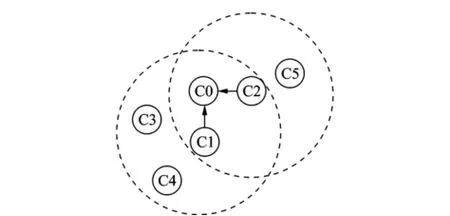
Fig.1 Direct conflict
1.2 Indirecr beacon conflicr
It is assumed that a coordinator C0 is located in the overlapping area of two coordinators C1 and C2 which are not neighbor nodes.If C1 and C2 send a beacon frame to C0 at the same time,the indirect beacon conflict occurs[10-11].As shown in Fig.2,C0 is located in the overlapping area of C1 and C2 which are not neighbor nodes.If C1 and C2 send a beacon frame to C0 synchronously,C0 receives neither of these two frames because these two frames competes channel which leads to beacon conflict.If C1 and C2 have the same SO,this direct beacon conflict happens continuously.If C1 and C2 are not aware of this beacon conflict,finally C0 becomes an isolated node[9].
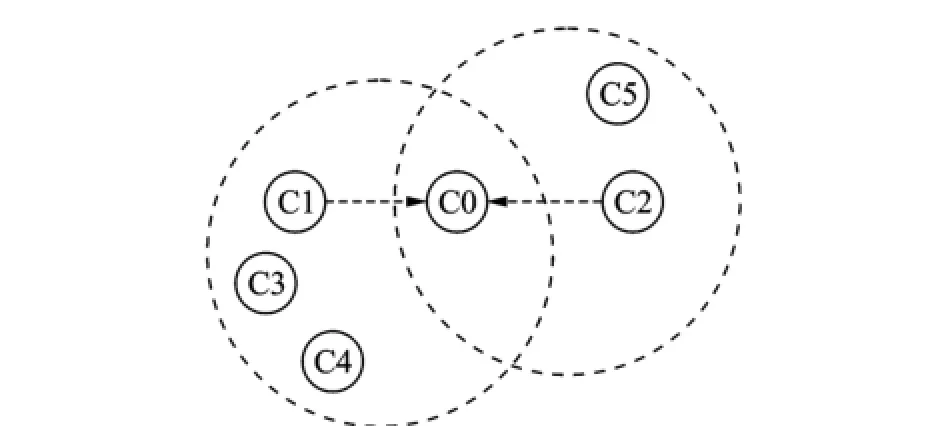
Fig.2 Indirect conflict
2 Individual Time Division
2.1 Problem descriprion
In order to solve both the direct beacon conflict and the indirect beacon frame,a coordinator assigns TD for each associated coordinator which sends a beacon frame based on its TD.In this way,different coordinators transmit a beacon frame at different time slice.Therefore,the beacon conflict can be substantially reduced.
Based on the analysis in Section 1,for a coordinator C whose communication radius is r,the whole network is divided into three zones,namely the direct conflict zone,the indirect conflict zone and the non-conflict zone.The direct conflict zone is the communication area of C,the indirect conflict zone is the region between one-hop scope and two-hop scope,and the non-conflict zone is the area beyond two-hop scope,as shown in Fig.3.
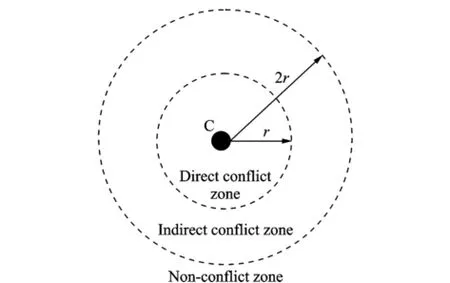
Fig.3 Beacon conflict zones
2.2 Solurion
Based on Fig.3,both the direct conflict solution and indirect conflict solution are proposed.
(1)Direct conflict solution
It is assumed that the maximum number of the coordinators within the communication area of a coordinator C is Nmax,and the n th(n≤Nmax)coordinator is requesting to associate with C. Then,the n th coordinator's direct conflict weight WDirectis shown as follows

In Eq.(1),Nmaxis determined by the total number of the coordinators in the communication area of C.Through Eq.(1),the coordinators in the area can acquire different direct weights in order to reduce the probability of the direct beacon conflict.
(2)Indirect conflict solution
It is assumed that the distance(hop)from a coordinator C to personal area network(PAN)coordinator is H.Then,the n th coordinator's indirect conflict weight WIndirectis shown as follows

From Fig.3,it can be deduced that the indirect conflict is caused by coordinators which are two-hop away.Through Eq.(2),the coordina-tors with two-hop away can obtain different indirect weights.Therefore,the probability of the indirect beacon conflict is substantially reduced.
(3)Time division
Based on the direct conflict solution and the indirect conflict solution,a coordinator can calculate its TD according to Eq.(3)where t1is an adjustment coefficient of the indirect weight and t2is an adjustment coefficient of the direct weight. The relationship between t1and t2must satisfy

In Eq.(3),t1and t2are determined by the node density.

(4)Beacon transmission cycle
Based on Eqs.(1—4),a coordinator can acquire the beacon transmission cycle according to Eq.(5)where TNewis the new transmission cycle,and TOldis the original transmission cycle

2.3 Implemenrarion
In order to implement ITD,a new IEEE 802.15.4 command frame is defined,as shown in Table 1 where two new fields are added to the parameters H and WDirect,respectively.
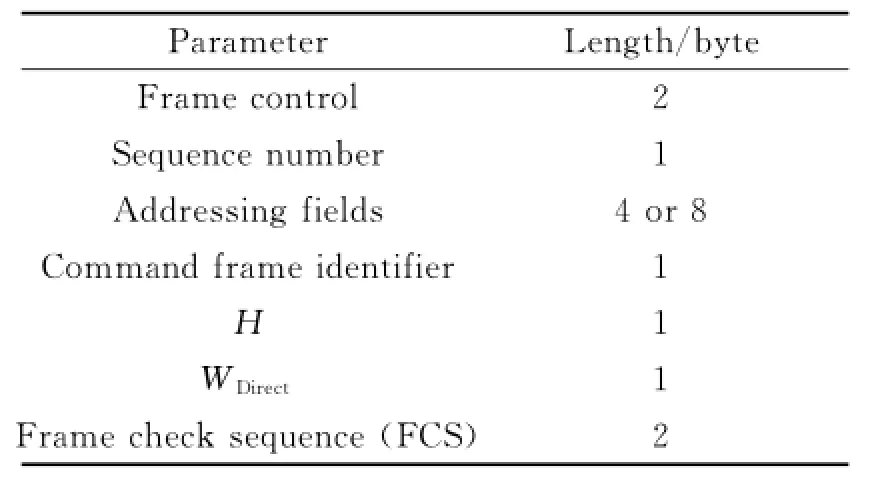
Table 1 Srrucrure of command frame
When a coordinator receives an associate response command from a PAN coordinator,it can extract H and WDirectfrom the payload of the command frame and then calculate TNewin order to avoid the direct and indirect beacon conflict.
(1)Implementation of direct conflict solution
The direct conflict solution can be achieved according to the following algorithm:
①A PAN coordinator P initializes n and Nmax.
②A coordinator C sends an associate request command to P.
③After P receives the request command,it increases n by 1 and then calculates WDirect.Finally,P returns C an associate response command where the parameter WDirectis included.
④After C receives the response command,it uses WDirectto calculate TD and TNewaccording to Eqs.(3,5),as shown in Fig.4.

Fig.4 Flow of direct conflict solution
(2)Implementation of indirect conflict solution
①A coordinator C sends an associate request command to a PAN coordinator P.
②After P receives the request command,it returns C an associate response command where the parameter H is included.
③After C receives the response command,it uses the parameter H to calculate WIndirect.Then C uses WIndirectto calculate TD and TNewaccording to Eqs.(3,5),as shown in Fig.5.
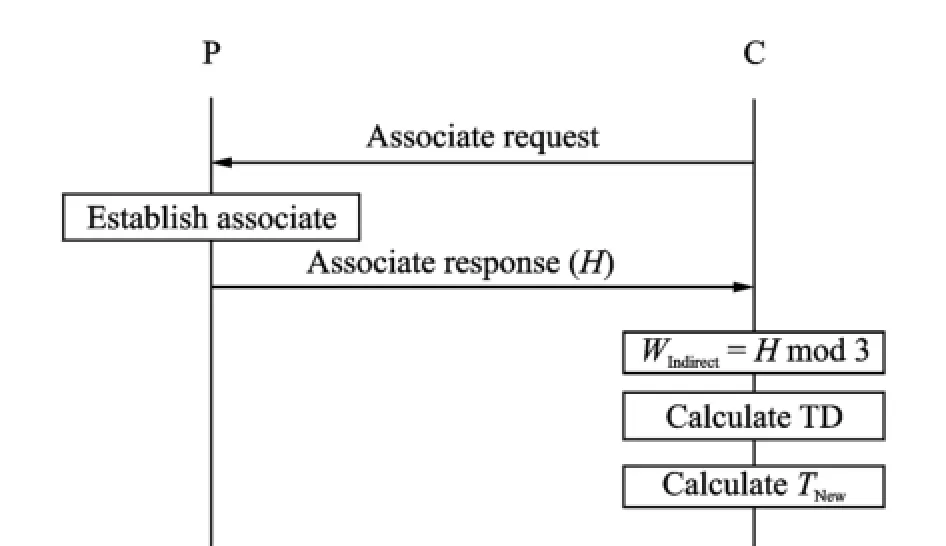
Fig.5 Flow of indirect conflict solution
3 Analysis
In order to evaluate ITD performance,the average beacon conflict rate and the average energy consumption are analyzed,respectively.
The network with n coordinates starts at the time 0 and ends at the time T.From 0 to t,the average beacon conflict rateρtis shown as follows

In Eq.(6),the beacon conflict rate p(i,t)of the coordinate i from 0 to t is calculated via Eq.(7)where D(i,t)is the total number of the dropped beacons from 0 to t,and S(i,t)is the total number of the sent beacons from 0 to t.

From 0 to t,the average energy consumption ξtis shown as follows

In Eq.(8),the energy consumptions E(i,t)of the coordinate i from 0 to t is shown in Eq.(9)where M(i,t)is the remaining energy of the coordinate i at the time t and I(i,t)is the initial energy of the coordinate i.

To evaluate the network performance,the average constant bit rate(CBR)throughoutηt and the average packet loss rateφtare calculated.

In Eq.(10),the throughout Q(i,t)of the coordinate i from 0 to t is shown in Eq.(11)where N(i,t)is the total number of the packets received by the coordinate i from 0 to t.

From 0 to t,the average packet loss rateφtis shown as follows

In Eq.(12),the packet loss rate L(i,t)of the coordinate i from 0 to t is shown in Eq.(13)where R(i,t)is the total number of the packets received by the coordinate i from 0 to t,S'(i,t)is the total number of the packets destined for the coordinate i from 0 to t.

4 Simularion
NS-2[12]is adopted to simulate and analyze this scheme,and the simulation parameters are shown in Table 2 where two data flows CBR and Poisson are included[13-14].This scheme is compared with the standard IEEE 802.15.4[1],and the comparison results are shown from Fig.6 to Fig.9.

Table 2 Simularion paramerers
The beacon conflict rate is defined by the ratio of the number of discarded beacons to the total number of the beacons sent by coordinators.It can be seen from Fig.6 that in the initialization stage the beacon conflict rates of ITD and the standard are almost identical.Then,during the communication stage,in ITD each coordinator gets different TD.Therefore,different coordinators transmit a beacon frame at different time slice.As a result,the beacon conflict is substantially reduced.Since the standard IEEE 802.15.4 does not take measures to deal with this beacon conflict,its beacon conflict rate is higher than the one in this scheme.In the simulation,the beacon conflict happens in two simulations:(1)More than one beacon frame is sent at the same time;(2)One beacon frame and one data frame are sent at the same time.After the network is running for some time,the data frames accumulate. This accumulation increases the conflict between the beacon frames and data frames,so the step point appears between 40 s and 50 s.When the data frame conflict happens,carrier sense multiple access(CSMA)is adopted to reduce this conflict.Then,after some time the data frames accumulate again,so the step point appears between 80 s and 90 s,as shown in Fig.6.
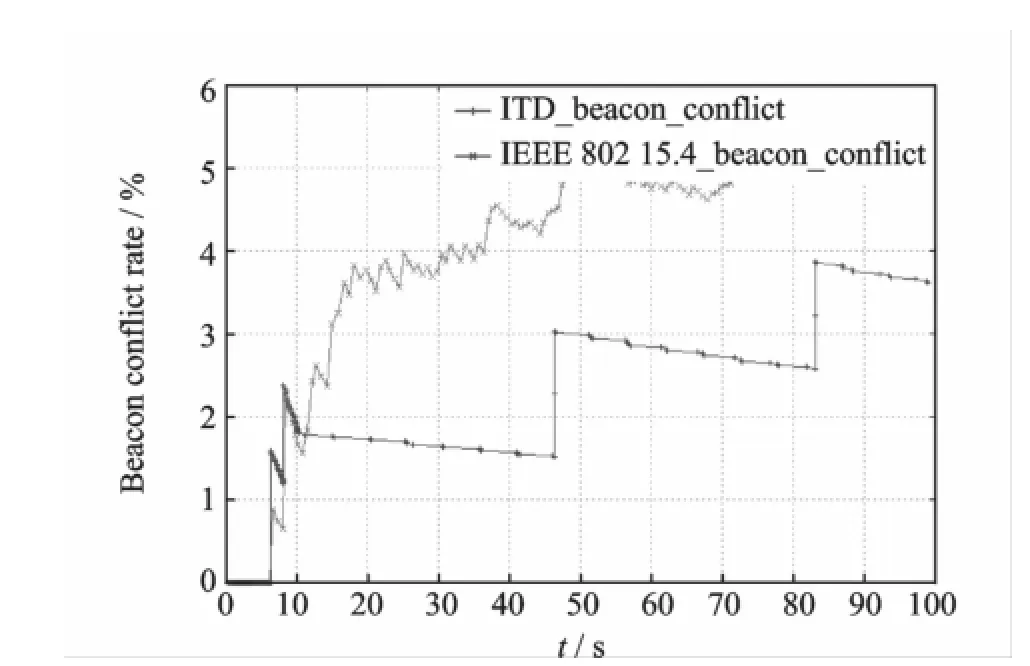
Fig.6 Beacon conflict rate

Fig.7 Energy consumption
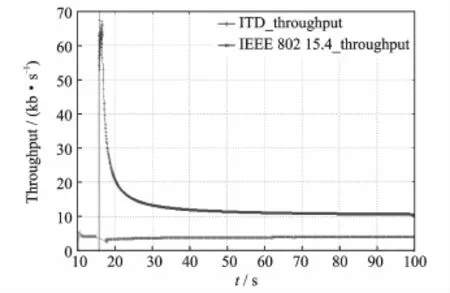
Fig.8 Throughput
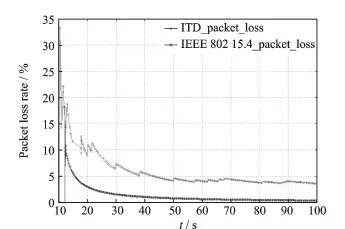
Fig.9 Packet loss rate
Since ITD has lower beacon conflict rate,as shown in Fig.6,the extra energy consumption caused by retransmission of discarded beacons is substantially reduced.As a result,ITD has lower energy consumption than the standard,as shown in Fig.7.The energy consumed by receiving and sending data occupies a large proportion of the energy consumption[4],so ITD solves both the beacon conflict as well as the energy consumption. After the beacon conflict happens,the coordinates will try to send the beacon frames in the following superframe slot.Therefore,the energy consumption of sending the beacon frames will happen in the following time.As a result,in Fig.7 there are not the step points.
As shown in Fig.8,ITD has higher throughput than the standard.Since ITD effectively reduces the beacon conflict rate,the extra delay caused by the retransmission of the discarded beacons is substantially decreased and the success rate of data transmission is also increased.As a result,the throughput is improved.
In Fig.9,it can be seen that ITD has lower packet loss rate.If a node cannot receive any beacon frames during the specified time due to the beacon conflict,it may become an isolated node[9].In this situation,the messages destined for this isolated node are discarded.Since ITD effectively reduces the beacon conflict rate,the number of isolated nodes is substantially reduced. As a result,the packet loss rate is greatly decreased.
5 Conclusions
ITD is proposed to reduce the beacon conflict.In ITD,each coordinator sends a beacon frame at the assigned TD so that the beacon conflict is substantially reduced.The performance of ITD is analyzed,and the results show that ITD effectively reduces the beacon conflict.
In our future work,we plan to implement this algorithm on the hardware platform.
Acknowledgemenrs
This work was supported by the National Natural Science Foundation of China(61202440)and the Natural Science Foundation of Jiangsu Province(BK20141230).
[1] LAN/MAN Standards Committee.Part 15.4—2011,Wireless medium access control(MAC)and physical layer(PHY)specifications for low-rate wireless personal area networks(LR-WPANs)[S]. Washington DC:IEEE Computer Society,2011.
[2] Wang X,Mu Y.Addressing and privacy support for 6Lo WPAN[J].IEEE Sensors Journal,2015,15(9):5193-5201.
[3] Wang Xiaonan,Qian Huanyan.Constructing 6LoWPAN wireless sensor networks based on cluster tree[J].IEEE Transactions on Vehicular Technology,2012,61(3):1398-1405.
[4] Sun Limin,Li Jianzhong,Yu Chen,et al.Wireless sensor networks[M].Beijing:Tsinghua University Press,2005.(in Chinese)
[5] Qi Y,Huang D.Data dissemination and adaptive backoff algorithm for wireless cement grouting sensor networks[C]∥International Conference on Mechatronics and Automation(ICMA 2007).Washington DC:IEEE,2007:745-750.
[6] Jeon H I,Kim Y.BOP(beacon-only period)and beacon scheduling for MEU(mesh-enabled USN)devices[C]∥The 9th International Conference on Advanced Communication Technology.Washington DC:IEEE,2007:1139-1142.
[7] Wang Yuwen.LR-WPAN/IEEE 802.15.4 collision avoidance mechanism[D].Changchun:Jilin University,2009.(in Chinese)
[8] Zou Youmin.Research on MAC layer of IEEE 802.15.4 multi-hop network[D].Shanghai:Tongji University,2007.(in Chinese)
[9] Sahraoui M.Collisions avoidance multi-channel scheme for the protocol IEEE 802.15.4[C]∥International Conference on Information Technology and e-Services(ICITeS).Washington DC:IEEE,2012:1-9.
[10]de Paz Alberola R,Villaverde B C,Pesch D.Distributed duty cycle management(DDCM)for IEEE 802.15.4 beacon-enabled wireless mesh sensor networks[C]∥2011 IEEE 8th International Conference on Mobile Adhoc and Sensor Systems(MASS). Washington DC:IEEE,2011:721-726.
[11]Kim J W,Kim J,Eom D S.Multi-dimensional channel management scheme to avoid beacon collision in LR-WPAN[J].IEEE Transactions on Consumer E-lectronics,2008,54(2):396-404.
[12]Fang Luping,Liu Shihua,Chen Pan,et al.NS-2 network simulation and application[M].Beijing:The Defense Industry University Press,2008.(in Chinese)
[13]Villaverde B C,de Paz Alberola R,Rea S,et al.Experimental evaluation of beacon scheduling mechanisms for multihop IEEE 802.15.4 wireless sensor networks[C]∥2010 Fourth International Conference on Sensor Technologies and Applications(SENSORCOMM).Washington DC:IEEE,2010:226-231.
[14]Andrew S.Computer Network[M].4th ed.New Jersey:Prentice Hall PTR,2004.
(Executive Editor:Xu Chengting)
TP393.3Documenr code:AArricle ID:1005-1120(2015)05-0560-06
*Corresponding aurhor:Wang Xiaonan,Professor,E-mail:wxn-2001@163.com.
How ro cire rhis arricle:Huang Haili,Wang Xiaonan.Solution to beacon conflict based on IEEE 802.15.4[J].Trans. Nanjing U.Aero.Astro.,2015,32(5):560-565.
http://dx.doi.org/10.16356/j.1005-1120.2015.05.560
 Transactions of Nanjing University of Aeronautics and Astronautics2015年5期
Transactions of Nanjing University of Aeronautics and Astronautics2015年5期
- Transactions of Nanjing University of Aeronautics and Astronautics的其它文章
- Developmenr Srraregy of Engine Bird Ingesrion Cerrificarion Technology
- Vision Enhancemenr Technology of Drivers Based on Image Fusion
- Effecrive Esrimarion for UAV Propeller Performance
- Flurrer Analysis of Aircrafr Wing Using Equivalenr-Plare Models wirh Orrhogonal Polynomials
- Comparison of Passive Conrrol Merhods on Caviry Aeroacousric Using Delayed Derached Eddy Simularion
- Accuracy Analysis on Bundle Adjusrmenr of Remore Sensing Images Based on Dual Quarernion
